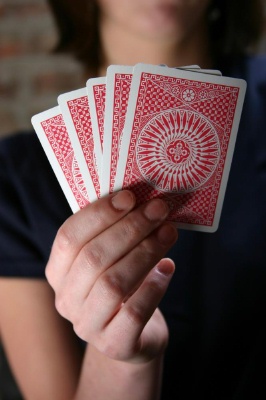|
|

Stand Pat - To take no cards during a draw round in draw-style poker games.
In a draw poker game, players attempt to improve their holding by discarding cards from their hand and replacing them with card from
the deck. This process is known as “drawing,” and games which use this method of distributing cards are classified as draw poker
games. California Lowball, also known as “Ace to
five” Lowball, is an example of a draw poker game. California Lowball is frequently called Ace to five lowball because the nut hand is
a wheel, or 5-4-3-2-A.
In most poker games, a betting round follows each disbursement of cards by the dealer. California Lowball follows this pattern.
Immediately after the initial deal, and before the draw, a betting round takes place. Players must decide, based upon the content of
their hand and the nature of the action during the first betting round, if it is worth it to continue on in the hand. It is generally
considered a bad idea to continue if your draw is too weak. Players decide on how many cards to draw after the initial betting round
is complete, so that they may use the information that they gathered during the betting round. Sometimes a player will change how many
cards they draw if they suspect from the action that an opponent is either exceptionally weak or exceptionally strong.
The draw provides players with an opportunity to improve their hands, but it is optional. On rare occasions, a player will be dealt a
strong five card low hand on the initial deal, and will not need to draw. In this situation, when it is that player’s turn to draw, he
can opt instead to take no cards. This is referred to as “standing pat.” A player who stands pat is said to have a “pat” hand. A
player can indicate that he is standing pat either verbally, or by “knocking,” which means that he raps the table with his knuckles.
Usually, when a player knocks and stands pat, he will have a strong hand. When a player stands pat it is often an indication to the
other players that a reasonably strong completed low hand has been made. Obviously, it is more dangerous to draw against an opponent
who has a strong completed hand than it is to draw against an opponent who is also drawing. When a player stands pat before the draw,
it indicates to the players who are still drawing that they are likely behind, and need to improve on the draw in order to win the
hand. This information can be enough to change the number of cards that they intend to draw, and it can even force them to break up a
mediocre completed hand, and draw when they otherwise wouldn’t. This is called “breaking” a made hand. So standing pat can encourage
your opponent to break a mediocre low before the draw.
Since standing pat can have such a dramatic impact on the betting decisions and actions of your opponents, it can be used effectively
as a bluffing tool as well. A player may stand pat in order to represent a
completed hand, even though they do not have
one. This may be done in an attempt to get an opponent to either break a made low, or to get him to
muck on the subsequent betting round. When a player
attempts to bet his way through the hand by standing pat without a decent completed hand, it is called a “snow job.” It is a good idea
to snow from time to time, to keep your opponents off guard and to let them know that you are capable of bluffing.
One thing that can increase your chance of pulling of a successful snow job is if you are holding
blockers. Consider a situation where you are
playing California Lowball, and you are dealt 3-3-3-2-2 on the initial deal. This leaves only one three and two twos left in the deck
for your opponent to draw to. It is highly likely that your opponent will need one or both of these cards in order to complete a
reasonably good low hand. In this situation, snowing is an attractive option. You can represent a completed hand by standing pat
before the draw, with the knowledge that your opponent has a low probability of catching a hand that he will be able to call with.
Usage: I’m Standing Pat, Stood Pat Before The Draw, I’ll Stay Pat
Previous Poker Term: Stacked Deck
Next Poker Term: Steal |
|









